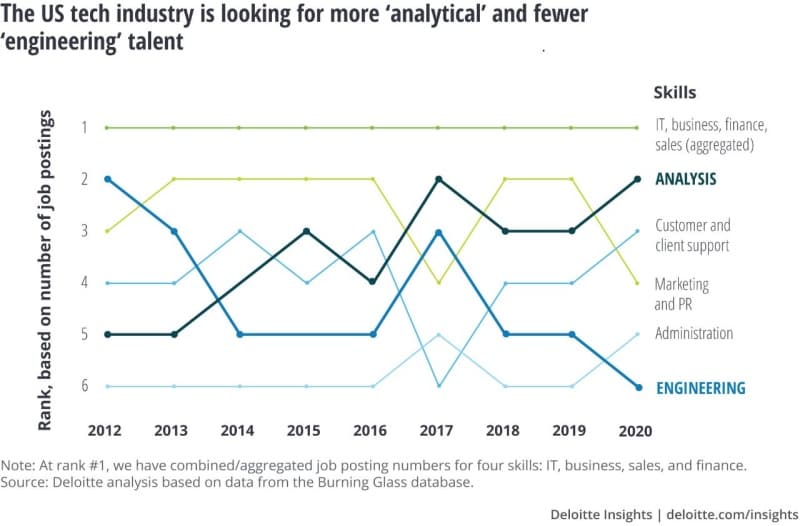Another most notable trend over the past eight years: the relative decline of the importance of core engineering skills. While engineering remains a critical asset, the rise in cloud and XaaS services has affected computer and hardware roles such as server administrators, computer hardware support technicians, and professionals who work on the hardware side of router and storage management.2 The COVID-19 pandemic has hit electrical and hardware design engineering roles harder than others in the tech industry.3 By contrast, even as the pandemic was worsening business conditions in spring 2020, tech majors’ job openings for data analyst, data engineer, and data architect roles continued to trend high.4
Tech companies have long been at the forefront of attracting professionals with advanced analytical skills,5 and since 2014, tech recruiters have particularly targeted professionals with math and statistical skills, looking to harness their ability to study and analyze data to help solve real-world business issues.6 The race to AI has accelerated the crunch, as the top Silicon Valley companies have ramped up their workforce aggressively, focusing on advanced analytical skills such as ML, natural language processing, data engineering, and data visualization and image processing.7 Demand for data scientists and ML and AI specialists began surging in 2016.8
Tech companies continue to ramp up data scientist and data analyst talent.9 However, with businesses across industries scrambling to acquire AI talent and to increase their own data-driven decision-making, demand for data analytics professionals will likely outstrip the available talent for some time.10
Tech companies can navigate this complex talent landscape with a blend of tactics, such as taking a deliberate approach to recruiting new analytical talent, tapping existing workers’ potential, and fostering strategic partnerships.
Considerations for tech industry execs
Selective hiring. Governed by strategic business objectives, executives can take a selective approach to assess whether analytics specialists are really needed, or if the goals can be accomplished with automated tools, XaaS programs, or AI-based services.
Focused and targeted reskilling. Leaders can look to elevate current employees’ skill levels on specific data and analysis fields such as ML, data analytics, data modeling, data architecture, and data engineering.
Strengthening partnerships. Tying up with academia and universities, business incubators and accelerators, and the startup ecosystem to tap and bring the best and most-relevant data and analytics professionals into the fold.














